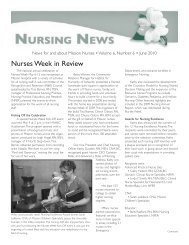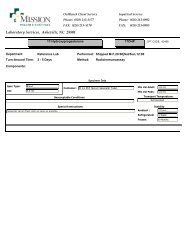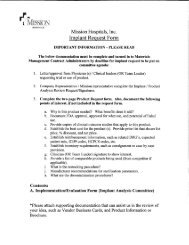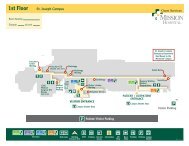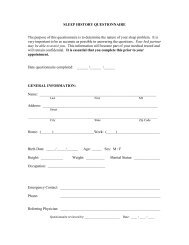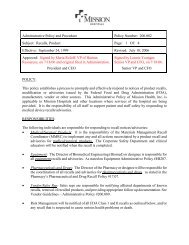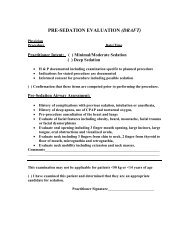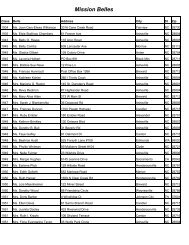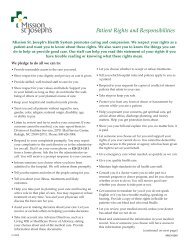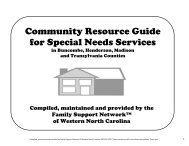New Beginnings: Pregnancy Guides - Mission Health
New Beginnings: Pregnancy Guides - Mission Health
New Beginnings: Pregnancy Guides - Mission Health
You also want an ePaper? Increase the reach of your titles
YUMPU automatically turns print PDFs into web optimized ePapers that Google loves.
Ligaments of the uterus: There are<br />
ligaments attached to the outside of the<br />
uterus and your body. They keep the<br />
uterus from moving around in the<br />
abdomen. If the ligament stretches too<br />
quickly it can cause pain in the low<br />
belly. The pain is usually on the left or<br />
right side below the belly button.<br />
Pelvic floor muscle/Kegel exercise: Your<br />
body has muscles that hold your baby,<br />
uterus, bladder and intestines up<br />
inside. These are called the pelvic floor<br />
muscles. Kegel exercises help those<br />
muscles stay strong.<br />
To do a Kegel: Tighten your bottom like<br />
you are trying to stop your urine from<br />
coming out. Hold these muscles tight<br />
for 5 seconds. If you do this 20-30 times<br />
a day you will feel better. It can help<br />
keep urine from leaking when you cough<br />
or sneeze. It will also help your muscles<br />
work better when you are birthing.<br />
Quickening: The first movements of the<br />
baby that the mother feels. Movement<br />
is usually felt between 16 and 22 weeks.<br />
Vulva: The female genitals that are<br />
covered with pubic hair.<br />
W HAT W ILL H APPEN AT<br />
M Y C HECK- UPS<br />
• After about 12 weeks, they will start<br />
listening to your baby’s heartbeat.<br />
• They will ask you to watch for first<br />
movements of the baby. Try to<br />
remember the date.<br />
• The following tests may be offered<br />
or suggested:<br />
16 to 18 weeks<br />
Alpha-fetoprotein (AFP or Triple Screen):<br />
A blood test that screens for<br />
problems with the spinal cord or<br />
other chromosomal problems like<br />
Down’s syndrome.<br />
Amniocentesis: A test of amniotic fluid<br />
that can tell about genetic problems.<br />
18 to 20 weeks<br />
Ultrasound: A test that uses sound<br />
waves through the abdomen of the<br />
mother to make a picture of the baby.<br />
It can tell how many babies are in the<br />
uterus, how the baby is growing and<br />
how the placenta is working.<br />
26 to 28 weeks<br />
O’Sullivan: A blood test to look at the<br />
sugar in your blood. If your blood<br />
sugar is too high, a GTT (3 hour<br />
Glucose Tolerance Test) will be done.<br />
These tests check for diabetes in<br />
pregnancy (Gestational Diabetes).<br />
Some things you might want to talk<br />
about with your care provider at<br />
your prenatal check-ups:<br />
1. What do I need to know<br />
about traveling<br />
2. Am I at risk for preterm labor<br />
3. How can I have a healthier pregnancy<br />
4. Are there classes I should take<br />
5. Are there books or videos I should get<br />
6. Can I try to have a vaginal birth if I<br />
already had a cesarean birth What<br />
do I need to know<br />
7. Do you suggest using a doula for help<br />
in labor<br />
8. Are there medical problems in our<br />
families (mine and my partner’s) that<br />
should be checked out by the Fullerton<br />
Genetics Center<br />
Examples:<br />
- Sickle cell anemia<br />
- Cystic fibrosis<br />
- Muscular dystrophy<br />
- Birth defects (cleft palate, heart<br />
defects, spina bifida)<br />
- Mental retardation<br />
- Two or more unexplained<br />
miscarriages<br />
20<br />
9. Are the following safe during<br />
pregnancy:<br />
- Herbs<br />
- Homeopathics<br />
- Chiropractic Care<br />
- <strong>Pregnancy</strong> Massage<br />
- Spas (hot tubs)<br />
B ABY<br />
At the end of your fourth month your<br />
baby has grown to about 6 inches and<br />
weighs about 5 ounces. The sex of your<br />
baby may be seen by ultrasound. Small<br />
eyebrows and eye lashes have formed. A<br />
fine, thin hair (lanugo) covers your baby’s<br />
body. Your baby begins to look more<br />
like a human. Fingernails and toenails<br />
are forming.<br />
At the end of the fifth month your baby<br />
has grown very fast and is about 8-12<br />
inches long and weighs 8 ounces to 1<br />
pound. A white creamy substance<br />
(vernix) covers your baby to protect the<br />
skin. Hair has started to grow on the<br />
head. Your baby practices swallowing,<br />
sucking and breathing movements.<br />
Your baby’s first teeth have formed in<br />
the gums. The bones inside the ear have<br />
formed and your baby can hear the<br />
outside world.<br />
At the end of the sixth month your<br />
baby’s eyes begin to open and close.<br />
The first bowel movement (meconium)<br />
is forming in the intestines. The lungs<br />
are formed, but not ready to work on<br />
their own. The baby can cough and<br />
hiccup. Sweat glands are forming in the<br />
skin. Your baby is about 12-14 inches<br />
and weighs 1 1 /2 to 2 pounds.<br />
FATHER/PARTNER<br />
As the early weeks of pregnancy have<br />
now passed, you may be thinking more<br />
about the future. You may have the<br />
following questions:



